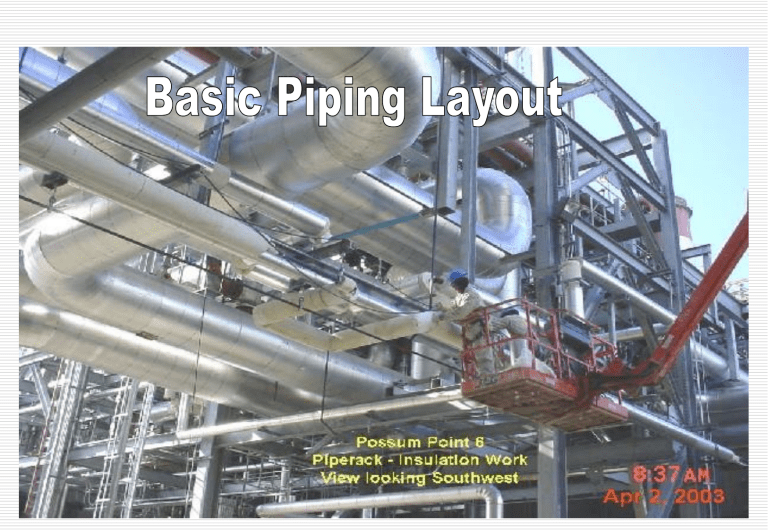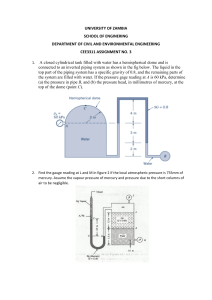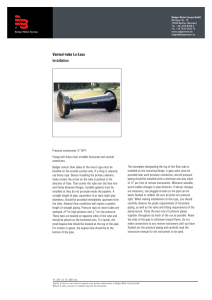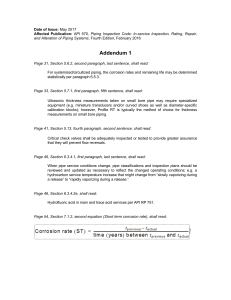
Basics of Piping layout Activities Involved Pipe Rack Planning/Area Planning Pipe Routing/modeling Interference check Discrepancy check Visual walk through of plant model Preparation of piping isometric drawings Preparation of Piping composite drawings Inputs Required Plot Plan G.A. drawing of building or specific area Equipment GA drawings 3 D Models Civil/ Structural drawings Piping and Instrumentation Diagrams (P&IDs) Terminal Point Details In Line Component details Instrument installation drawings or guide line. Design Criteria document Piping Design Tables (PDTs) Piping Layout Considerations: Operation Maintenance Constructability Economics Safety Aesthetics A B C Pipe racks and Pipe Trenches Piping outside process units shall be supported on sleepers, at ground level in Pipe racks or below ground level in Pipe Trenches. The choice between Pipe tracks and Pipe trenches is dictated by technical and economic considerations. The distance between sleepers in pipe tracks and in pipe trenches shall be based on maximum allowed free span of the majority of pipes. Elevation of sleepers shall be such that there is access for maintenance and for operation of valves, drains and instrumentation. Flanged connection shall not be installed in trenches. Concrete trenches shall be adequately drained. The Headroom normally provided is as below. Sr. No. 1. 2. 3. 4. 5. Description Clear head room under Structures/pipe lines inside operating area. Head room over rail (from top of rails) Clear headroom above crest of road for crane movement. Clear headroom above crest of road for truck movement. Clear headroom above crest of road between Headroom (mm) 2200 7000 7000 6000 4500 Flexibility Flexibility General Piping layout Guidelines Shall be done in line with process requirement. Bottom of lines should be on same elevation. Avoid pipe in Trenches. Avoid valves in vertical run Proper accessibility of inline components Pipe to pipe spacing shall be as recommended Distance between pipes shall allow for turning of spectacle blind, if present. Piping shall be supported properly. Standard and easily available pipe fittings to be used. For large dia buried pipe line air release valves, manholes to be provided. Slopes to be provided in pipeline as per the process requirement. General Piping Layout Guidelines For cold lines with stretch beyond 80 meter, expansion loop shall be provided. Flanges installed to facilitate maintenance and inspection. Branch connection for air, steam or gas line should be on top and for water or liquid line should be from bottom of main header. Installation of valves. Control valve installation. Drain and vent connections. Specific guidelines for piping around Pumps General Strainers Pressure relief Suction piping of centrifugal pumps Specific guidelines for Fuel Gas Piping Branch connection taken from top of main header. All flanged joints shall be provided with jumper arrangement to avoid any discontinuity which may cause sparking due to static electricity generation and shall be suitably earthed afterwards. Specific guidelines for Tank Farm Area Piping Within the bund/dyke area the number of pipes shall be minimized and shall be routed in shortest practicable way. Pipes shall be grouped together Pipes connected to tanks shall be sufficiently flexible to cope with thermal expansion/contraction. Piping shall be connected and supported after hydrostatic testing of tank. Piping shall be supported by concrete sleepers or steel frames. There shall be access to manholes, mixing nozzles, drains and other facilities on the tanks. Specific guidelines for Steam Piping Branch lines from steam header should be taken from top of header Low point drains should be provided in steam lines Drain should be provided upstream side of valve Loop shall be provided to provide flexibility in long straight run of pipe All steam piping should be sloped down in the direction of flow a minimum of 5mm/meter or as specified All high points should be vented Temperature elements (TI, TW, TE) tap point shall be provided on top and pressure elements tap points shall be provided in horizontal direction. All valves shall be placed at accessible position. All steam lines shall preferably be supported from top. Specific guidelines for Large Diameter Piping Pipes DN 900 and Larger shall be provided with inspection and maintenance manholes of minimum size DN 600 and distance between manholes should be no more than 100m Cooling towers shall have isolation valves Main distribution pipes shall have drain and vent facilities. Underground piping shall have minimum 1.0m soil cover Mitre bends to be used for 90 degree or 45 degree bends. Tees should generally be welded. Piping For Instruments Flow measurement instruments need certain straight length, normally 15D on the upstream and 5D on downstream. Pipe lines in which flow meters are located should be fill with Liquid all the time. Isolation valves for level gauges and pressure gauges shall be made accessible. Rotameters shall be placed on vertical line and the inlet should be from the bottom of the instrument Specific requirements for instrument installation to be checked, like temperature gauge can not be installed in pipe which is less than 4 inch in size Enough operating and maintenance access shall be considered while locating any instrument. Verification Points The layout to be checked properly considering support location, feasibility of supports. Accessibility of all inline valves, instruments, equipment to be checked. Piping layout should be interference free. Piping Layout should be inline with P&ID. Sufficient gaps are maintained between pipes for the expansion due to high temperature. Piping layout to be checked with analysis for flexibility. Nozzle loads for Piping connection with any equipment should be within vendor certified allowable limit. Layout to be checked for upstream downstream length requirements of flow elements. Work Process MPD7.01 Isometric check list Suction of Pump Valve location Easily accessible 1200-1500mm from operating level Chain arrangement should be provided where ever required Pipe line Vents and Drains Pipes are also slopped towards low points.






